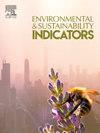热带流域土地利用和气候变化下地下水补给潜力的ahp -机器学习混合模型:对可持续水管理的影响
IF 5.6
Q1 ENVIRONMENTAL SCIENCES
引用次数: 0
摘要
撒哈拉以南非洲地区的地下水补给日益受到气候变化和土地利用/土地覆盖(LULC)变化的威胁,但对热带盆地的综合评估仍然有限。本研究使用一种结合层次分析法(AHP)和机器学习的新型混合方法来评估加纳普拉河和安科布拉河流域的地下水补给潜力,以评估气候- lulc耦合影响。该框架集成了统计上缩小的CMIP6预估(SSP1-2.6、SSP2-4.5、SSP5-8.5)、基于随机森林的LULC建模和ahp加权多标准分析。模拟方法实现了精确的降雨降尺度(RMSE = 5.56 mm/d, R2 = 0.79),而土地变化模型预测了LULC的转变(精度= 0.81,Kappa = 0.55)。结果表明,气候变化主导着补给变率,SSP1-2.6扩展了非常高补给区(+ 91.90%),SSP5-8.5减少了非常低补给区(- 67.94%)。出现非线性响应,包括初始高补给下降(近期- 8.72%),随后恢复(中期+ 34.31%)。从空间上看,安科布拉盆地和普拉盆地中西部地区补给潜力最大(14.84%非常高),东南部地区补给潜力较弱(5.79%非常低)。AHP确定降雨(权重= 0.22)、地质(0.20)和沉积物密度(0.14)是关键控制因素。混合ahp -机器学习方法优于传统方法,提供了气候- lulc相互作用的稳健量化。研究结果强调了适应性管理的必要性,优先考虑高补给保护(如Tarkwa)和脆弱地区(如Shama)的替代解决方案。该研究为热带盆地提供了一个可转移的框架,支持全球变化下的可持续地下水规划。本文章由计算机程序翻译,如有差异,请以英文原文为准。
Hybrid AHP-machine learning modelling of groundwater recharge potential under land use and climate change in tropical Basins: Implications for sustainable water management
Groundwater recharge in sub-Saharan Africa is increasingly threatened by climate change and land use/land cover (LULC) changes, yet integrated assessments remain limited for tropical basins. This study evaluates groundwater recharge potential in Ghana's Pra and Ankobra River Basins usings a novel hybrid approach combining Analytical Hierarchy Process (AHP) and machine learning to assess coupled climate-LULC impacts. The framework integrates statistically downscaled CMIP6 projections (SSP1-2.6, SSP2-4.5, SSP5-8.5), Random Forest-based LULC modelling, and AHP-weighted multi-criteria analysis. The Analog method achieved accurate rainfall downscaling (RMSE = 5.56 mm/day, R2 = 0.79), while Land Change Modeller predicted LULC transitions (precision = 0.81, Kappa = 0.55). Results indicate climate change dominates recharge variability, with SSP1-2.6 expanding very high recharge zones (+91.90 % mid-future) and SSP5-8.5 reducing very low zones (−67.94 % far-future). Nonlinear responses emerged, including an initial high-recharge decline (−8.72 % near-future) followed by recovery (+34.31 % mid-future). Spatially, the Ankobra Basin and mid-western Pra Basin exhibited the highest recharge potential (14.84 % very high), while southeastern areas remained vulnerable (5.79 % very low). AHP identified rainfall (weight = 0.22), geology (0.20), and lineament density (0.14) as key controls. The hybrid AHP-machine learning approach outperformed conventional methods, providing robust quantification of climate-LULC interactions. Findings emphasise the need for adaptive management, prioritising high-recharge conservation (e.g., Tarkwa) and alternative solutions in vulnerable zones (e.g., Shama). This study offers a transferable framework for tropical basins, supporting sustainable groundwater planning under global change.
求助全文
通过发布文献求助,成功后即可免费获取论文全文。
去求助
来源期刊

Environmental and Sustainability Indicators
Environmental Science-Environmental Science (miscellaneous)
CiteScore
7.80
自引率
2.30%
发文量
49
审稿时长
57 days
 求助内容:
求助内容: 应助结果提醒方式:
应助结果提醒方式:


